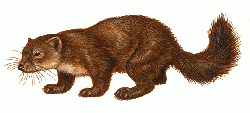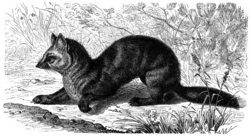Sable
 From Nwe
From Nwe | Sable | ||||||||||||||
|---|---|---|---|---|---|---|---|---|---|---|---|---|---|---|
 |
||||||||||||||
|
|
||||||||||||||
 Least concern |
||||||||||||||
| Scientific classification | ||||||||||||||
|
||||||||||||||
|
|
||||||||||||||
| Martes zibellina Linnaeus, 1758 |
Sable is the common name for a carnivorous mammal, Martes zibellina, of the marten genus (Martes) and weasel family (Mustelidae), characterized by a slender body, short limbs, bushy tail, and sharp-clawed, five-toed feet. Sables have been valued historically for their soft, thick, dark fur, which remains a luxury good to this day. The sable is found in northern Asia (Siberia, northern China, Japan); its distribution once extended west to Scandinavia, but it became extinct in the wild there (Bates 2002).
Sables play an important role in the health of ecosystems, helping to control small rodents, squirrels, and other animals, and probably contributing to seed dispersal, as with other martens, for those nuts and berries eaten as a secondary source when primary food sources are scarce (Buskirk and Ruggiero 1994; Willson 1993). For humans, sable has long been prized as a source of fur, so much so that populations of sables have been severely impacted, requiring measures to allow populations to recover and spurring raising of sables on fur farms.
The term sable also has become a generic description for some dark-furred animal breeds, such as sable cats or rabbits.
Overview
Family Mustelidae and genus Martes
Sables are members of the mammalian order Carnivora, which includes such familiar groups as dogs, cats, bears, and seals. There are over 260 species in Carnivora, which are divided into two main sub-orders: Feliformia (cat-like) and Caniformia (dog-like). The weasel family, Mustelidae, to which sables belong, is part of the subgroup Caniformia, which includes such major subgroups as the families Canidae (dogs, wolves, and foxes), Ursidae (bears), and Mephitidae (skunks), as well as the pinnipeds (seals, sea lions, and walruses).
The Mustelidae family includes 55 species of weasels, badgers, and otters), placed in 24 genera. This "weasel family" is a diverse family and the largest in the order Carnivora, at least partly because it has in the past been a catch-all category for many early or poorly differentiated taxa.
Mustelids (members of the Mustelidae family) vary greatly in size and behavior. The least weasel is not much larger than a mouse. The giant otter can weigh up to 76 lb (34 kg). The wolverine can crush bones as thick as the femur of a moose to get at the marrow, and has been seen attempting to drive bears from kills. The sea otter uses rocks to break open shellfish to eat. The martens, the group to which sables belong, is largely arboreal, while the badger digs extensive networks of tunnels, called setts. Within a large range of variation, the mustelids exhibit some common characteristics. They are typically small animals with short legs, short round ears, and thick fur.
Sables belong to the Martes genus within the subfamily Mustelinae, in family Mustelidae. Collectively, members of this genus are known as martens. They are slender, agile, animals, adapted to living in taigas, and are found in coniferous and northern deciduous forests across the northern hemisphere. They have bushy tails, and large paws with partially retractile claws. The fur varies from yellowish to dark brown, depending on the species, and, in many cases, is valued by fur trappers.
Sable

Sables comprise the species Martes zibellina. There is sexual dimorphism between females and males, with males being somewhat larger. Male body weight varies between 880 and 1800 grams and their body length varies between 380 and 560 millimeters, with relatively long tails between 90 and 120 millimeters. Females weigh between 700 and 1560 grams, with a body length of 350 to 510 millimeters and tails between 72 and 115 millimeters (Nowak 1999). Winter pelage is longer and thicker than their summer coat. Coloration varies in color from tan to black (Ognev 1962). The fur is somewhat lighter ventrally and a patch of gray, white, or pale yellow fur on the throat is common. The finest, darkest fur is highly prized and referred to as "black diamond."
The sable, along with the American marten (M. americana), the Eurasian pine marten (M. martes), and the Japanese marten (M. melampus) are closely related species grouped together as "boreal forest martens," being similar in size, shape, and ecology, and replacing each other geographically from east to west within the circumboreal zone from Newfoundland to Ireland (Buskirk and Ruggiero 1994).
The name sable appears to be of Slavic origin and to have entered Western European via the early medieval fur trade (Oxford English Dictionary 1989). Thus the Russian and Polish sobol became the German zobel, Dutch sabel. The French zibelline Spanish cibelina, cebellina, Finnish soopeli, and Mediaeval Latin zibellina derive from the Italian form. The English and Medieval Latin word sabellum comes from the Old French sable or saible.
Distribution and habitat
The sable is found in Russia from the Ural Mountains throughout Siberia, in northern Mongolia and China, and on Hokkaidō in Japan (Harrison 2004). Its range in the wild originally extended through European Russia to Poland and Scandinavia (Ognev 1962).
The sable inhabits forest environments, flatlands, and mountain ranges, including spruce and cedar forest in eastern Siberia and pine and larch forests in western Siberia, avoiding only mountain tops (Bates 2002; Grzimek 1990; Ognev 1962).
Behavior and reproduction
Sables are diurnal, mostly terrestrial carnivores, who typically prey on such vertebrates as squirrels, rodents, birds, and fish, although they have been known to eat berries, vegetation, and pine nuts when primary sources are scarce. Under extreme weather conditions, they may store prey in their den for later consumption (Bates 2002).
Sables construct dens on the forest floor. They may stay in these dens during snow stores or when being hunted by humans (Bates 2002).
In the wild, sables may be vicious; however, individuals taken from their mother at a young age may be domesticated, and have been described as playful, tame, and curious under such circumstances (Bates 2002: Ognev 1962).
Although small, the sharp teeth and fierce demeanor of sables discourages most predators.
Mating takes place between June 15 and August 15, depending on locality (Bates 2002). It can involve courting rituals between males and females and in areas where male ranges overlap, the competition can involve violent battles (Ognev 1962; Bates 2002). Litter size is typically two to three individuals, but can be from one to seven individuals (Bates 2002). The newly born young weigh between 25 and 35 grams and have unopened eyes; they only open their eyes between 30 and 36 days after birth, and shortly thereafter leave their nest (Bates 2002; Grzimek 1990). After seven weeks they are weaned and given regurgitated food (Ognev 1962; Bates 2002). Some paternal care has been observed, including protection of the females' territory and providing of food for the mothers and young (Bates 2002).
Sables in the wild are believed to have a lifespan of about eight years, although they have been observed to live up to 18 years in fur farms (Bates 2002).
History of exploitation and status
Sable fur has been a highly valued item in the fur trade since the early Middle Ages. Intensified hunting in Russia in the nineteenth and early twentieth century caused a severe enough decline in numbers that a five year ban on hunting was instituted in 1935, followed by a winter-limited licensed hunt. These restrictions together with the development of sable farms have allowed to species to recolonize much of its former range and attain healthy numbers (Grzimek 1990). The collapse of the Soviet Union led to an increase of hunting and poaching in the 1990s, in part because wild caught Russian furs are considered the most luxurious and demand the highest prices on the international market (Tyler 2000).
Currently, the species has no special conservation status according to the IUCN, though the isolated Japanese subspecies M. zibellina brachyurus, is listed as "data-deficient" (IUCN 2007).
Because of its great expense, sable fur is typically integrated into various clothes fashions, such as to decorate collars, sleeves, hems, and hats. The so-called Kolinsky sable-hair brushes used for watercolor or oil painting are not manufactured from sable hair, but from that of the siberian weasel.
While hunting of wild animals is still common in Russia, most fur in the market is now commercially farmed.
References
ISBN links support NWE through referral fees
- Bates, J. 2002. Martes zibellina Animal Diversity Web. Retrieved June 07, 2008.
- Buskirk, S. W., and L. F. Ruggiero. 1994. American marten Chapter 2 in L. F. Ruggiero, K. B. Aubry, S. W. Buskirk, L. J. Lyon, and W. J. Zielinski (eds.), The Scientific Basis for Conserving Forest Carnivores: American Marten, Fisher, Lynx, and Wolverine in the Western United States. Fort Collins, CO: USDA Forest Service. Retrieved June 7, 2008.
- Grzimek, B. 1990. Grzimek's Encyclopedia of Mammals. New York: McGraw-Hill Publishing Company. ISBN 0079095089.
- Harrison, D. J. (ed.). 2004. Martens and Fishers. (Martes) in Human-Altered Environments: An International Perspective. Springer-Verlag. ISBN 0387225803.
- International Union for Conservation of Nature (IUCN). 2007. Martes zibellina 2007 IUCN Red List of Threatened Species. Retrieved June 7, 2008.
- Nowak, R. M. 1999. Walker's Mammals of the World, 6th ed. Johns Hopkins University Press. ISBN 0801857899.
- Ognev, S. 1962. Mammals of Eastern Europe and Northern Asia. Jerusalem: Israel Program for Scientific Translations.
- Oxford English Dictionary. 1989. Sable, n., etymology of The Oxford English Dictionary, 2nd ed. 1989. OED Online. Oxford University Press. Retrieved February 11, 2008.
- Tyler, P. E. 2000. Behind the $100,000 sable coat, a Siberian hunter New York Times December 27, 2000. Retrieved June 7, 2008.
- Willson, M. F. 1993. Mammals as seed-dispersal mutualists in North America. Oikos 67(1): 159-176.
|
|||||||||||||||||||||||||||||||||||||||||||||||||||||||||||||||||||
Credits
New World Encyclopedia writers and editors rewrote and completed the Wikipedia article in accordance with New World Encyclopedia standards. This article abides by terms of the Creative Commons CC-by-sa 3.0 License (CC-by-sa), which may be used and disseminated with proper attribution. Credit is due under the terms of this license that can reference both the New World Encyclopedia contributors and the selfless volunteer contributors of the Wikimedia Foundation. To cite this article click here for a list of acceptable citing formats.The history of earlier contributions by wikipedians is accessible to researchers here:
- Sable history
The history of this article since it was imported to New World Encyclopedia:
- History of "Sable"
Note: Some restrictions may apply to use of individual images which are separately licensed.
↧ Download as ZWI file | Last modified: 02/03/2023 23:57:57 | 33 views
☰ Source: https://www.newworldencyclopedia.org/entry/Sable | License: CC BY-SA 3.0
 ZWI signed:
ZWI signed: KSF
KSF